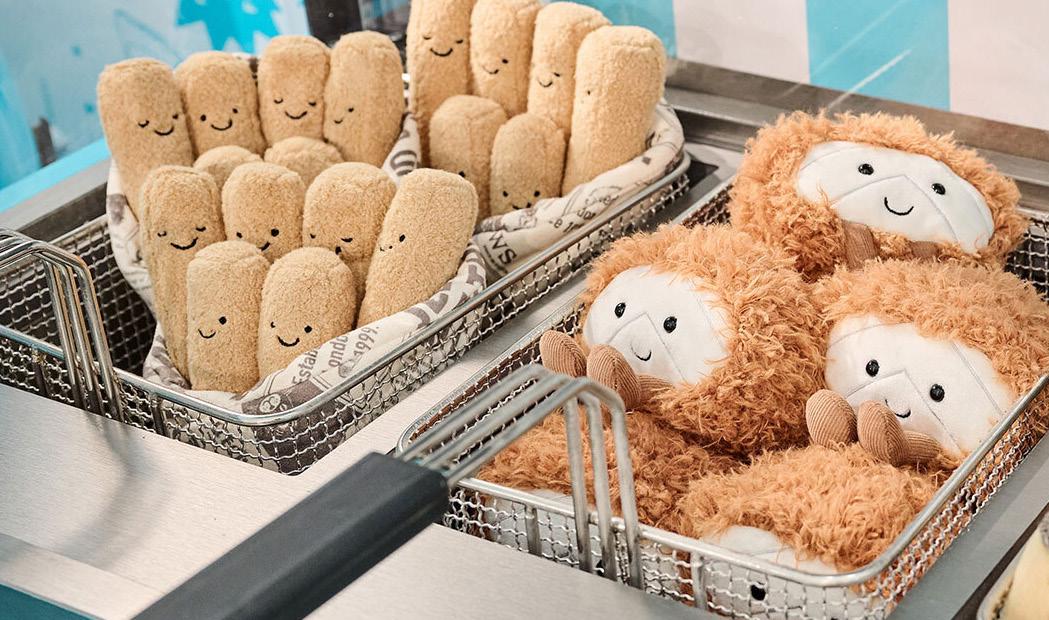JellyCat 2023 Annual Report






Born in London. Loved worldwide.
Jellycat is a popular brand known for creating high-quality, soft plush toys that appeal to both children and adults. The brand’s plush animals and other whimsical creatures are recognized for their distinctive designs, luxurious softness, and charming personalities.
For a q uarter of a century, we have shared the joy of Jellycat toys with people of all ages, across the globe. Over this time, our unmistakable characters have gained the affection of millions – and center stage in many of the most prestigious stores across 77 countries.
Our designers play until something magical and unexpected happens – and a new character is born! We source beautiful materials that are noticeably softer, subtler and long-lasting.
Jellycat is special because of the way they sit in your hand, the expression that speaks a thousand words or the feeling of holding one close to you… The answer is different for everyone. And that is the magic
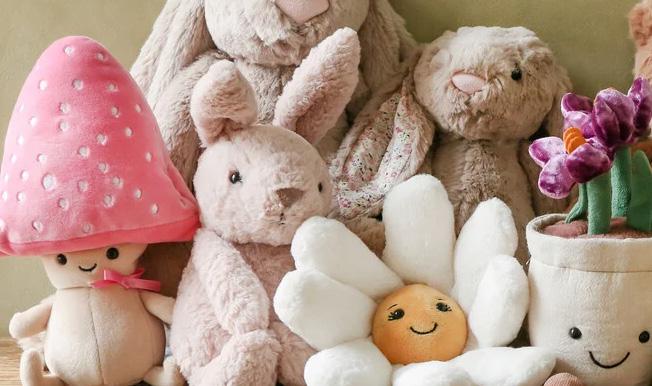
Jellycat, a British brand known for its whimsical and ultra-soft plush toys, was founded in London in 1999. The company’s name, “Jellycat,” came from an amusing combination of two things the founders loved—jelly and cats—creating a quirky image that matches the playful nature of their toys. From the beginning, Jellycat stood out with its unique designs, blending both classic and contemporary influences, and soon gained popularity with both children and adults.
In its early years, Jellycat quickly expanded its product range. Their plush toys became renowned for their softness, high-quality materials, and distinctive characters, like the iconic “Bashful Bunny” series, which became one of their best-selling lines. Over time, the company moved beyond traditional stuffed animals, introducing a wide range of creatures, from octopuses to pineapples, that added an extra touch of creativity to their offerings. As the brand grew, Jellycat expanded internationally, becoming a beloved name not just in the UK, but across the U.S., Europe, and Asia.
This global reach allowed them to build a strong following, with many fans collecting their various seasonal and themed releases. Holidays like Christmas and Easter saw Jellycat offering limited-edition plush toys, which contributed to the brand’s status as a favorite for both gifting and collecting.
In recent years, Jellycat has embraced sustainability and ethical production practices, aligning with the growing demand for responsible manufacturing. The company has focused on using safe, sustainable materials while ensuring that their production processes are ethical. Today, Jellycat continues to create delightful and imaginative plush toys, beloved by fans of all ages worldwide.
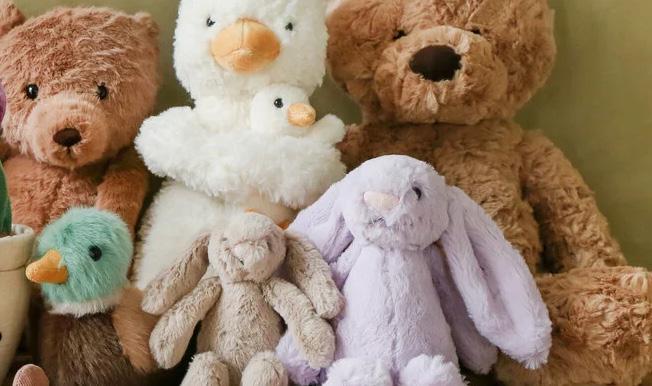

As we wrap up another remarkable year at Jellycat, it is my pleasure to share with you our 2023 annual report. This past year has been a testament to the power of creativity, the strength of community, and the joy that our brand continues to bring to people of all ages.
The Jellycat magic lives in every creation we craft. In 2023, our focus remained clear: to design and deliver irresistibly cuddly and quirky companions that spark the imagination. Whether it’s a favorite soft toy for a newborn or a whimsical plush for the young at heart, we continue to set the standard in design, quality, and fun. I am immensely proud of our team’s ability to consistently create products that offer comfort and joy in homes across the world.This year, we expanded both in scope and in vision. We introduced several new collections, including more sustainable options as part of our ongoing commitment
to the environment. As a brand that believes in making the world a softer place, we understand our responsibility to ensure that future generations can enjoy not only Jellycat products but a healthier planet. We’ve taken meaningful steps toward reducing our carbon footprint, improving material sourcing, and increasing the longevity and recyclability of our packaging.
Our global footprint also grew. We made significant strides in increasing our presence across new markets and strengthening relationships with retail partners worldwide. Our website has become a crucial part of the Jellycat experience, with more customers engaging with us directly online than ever before. We are thrilled by the positive response to our digital presence and will
continue to innovate in how we connect with our customers, both online and in-store. Looking forward to 2024, we are filled with excitement and optimism. Jellycat is more than a brand; it’s a trusted friend to millions of children, parents, and adults whofind joy in our quirky characters. We will continue to invest in bold, playful designs that surprise and delight our customers while deepening our commitment to sustainability and responsible production practices. We aim to reach new milestones as we work to build an even more inclusive and diverse community of Jellycat fans.
Our success this year would not have been possible without the incredible dedication of our employees, the enthusiasm of our customers, and the unwavering support of our shareholders and partners. Together, we’ve accomplished so much, and we have every reason to look ahead with confidence as we continue to grow and spread joy around the world.
Thank you for your continued support and belief in the Jellycat journey. With best regards,

Arnaud Meysselle CEO, Jellycat
Jellycat is committed to giving back through charitable partnerships and initiat ives, particularly those that support children’s welfare, education, and well-being. Over the years, Jellycat has donated toys and contributed

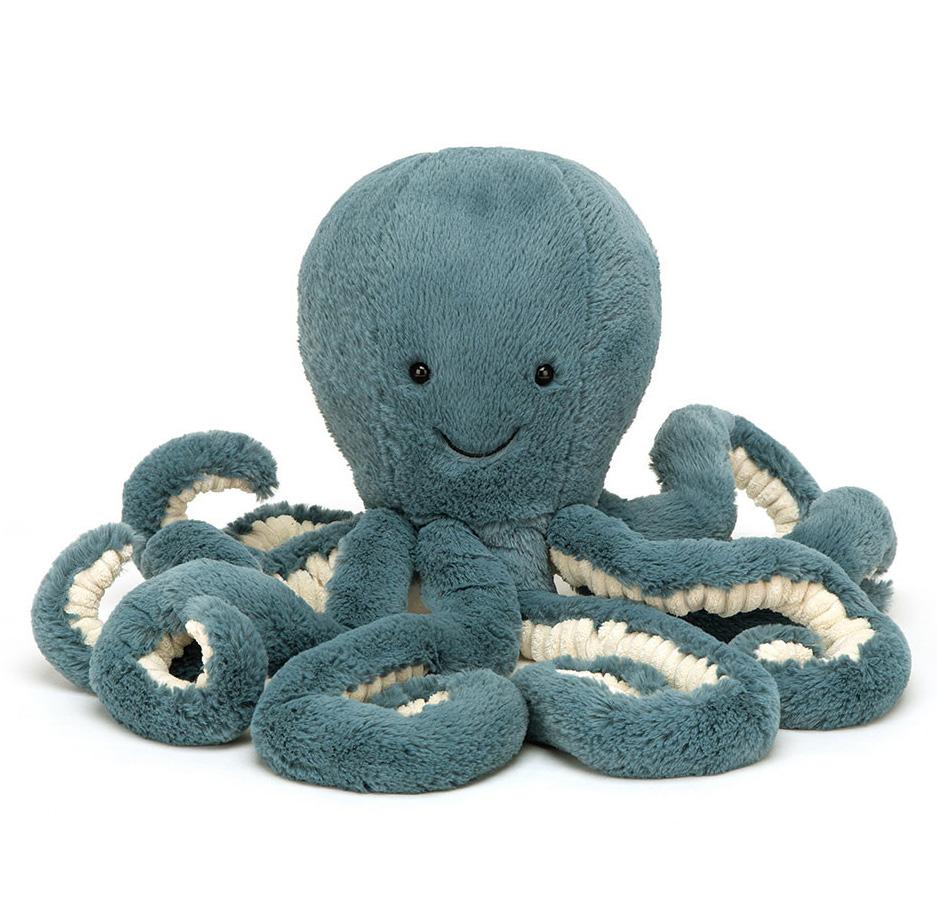
Jellycat’s loyal customer base continu es to grow, with a large community of fans across social media platforms and active engagement through online contests, user-generated content, and influencer partnerships.
Jellycat continues to set the bar for safety in the toy industry. All of its products adhere to the highest international safety standards, ensuring that every soft toy is safe for children of all ages. Jellycat’s unique designs have been recognized with various industry awards for creativity, craftsmanship, and innovation in toy design.
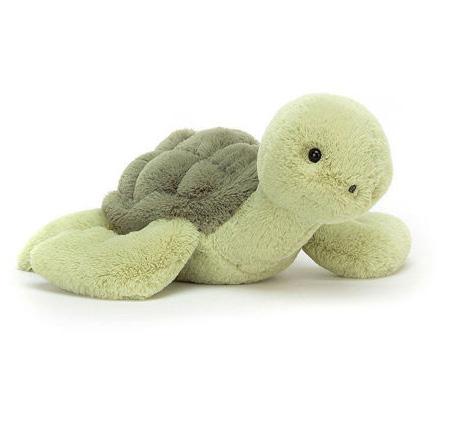
Jellycat has made strides in sus tainability by incorporating more environmentally friendly materials in its products. This includes the use of organic and recycled fabrics, responsibly sourced fibers, and reducing the environmental impact of
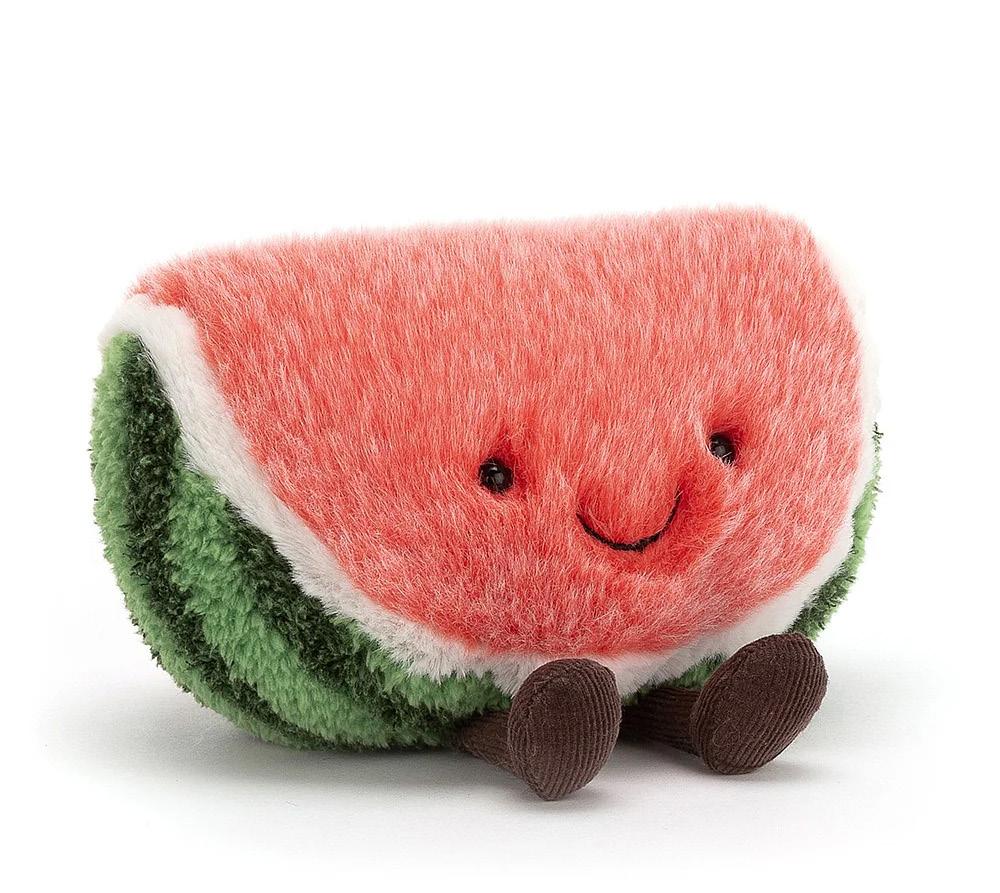
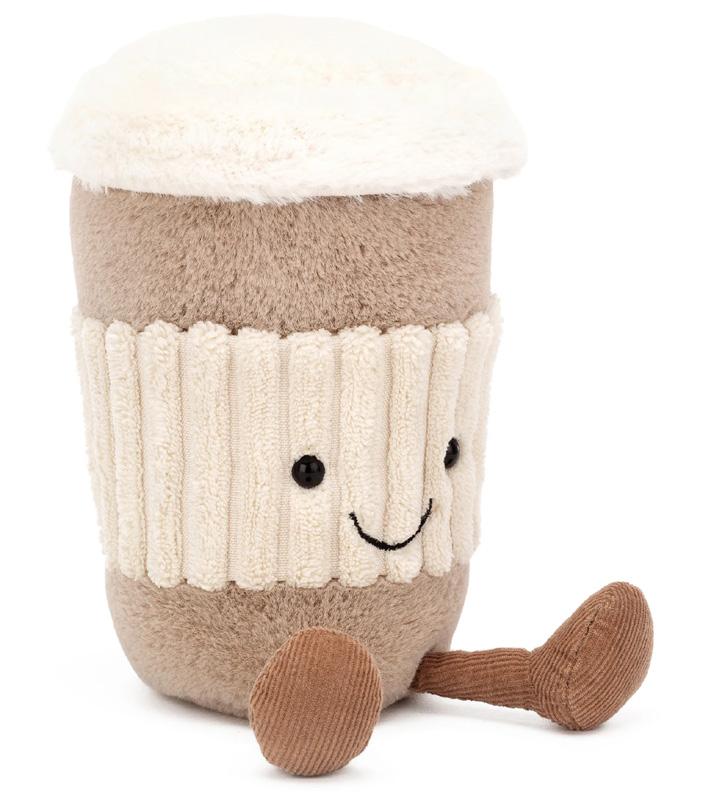
In ad dition to soft toys, Jellycat expanded its product portfolio to include new types of items such as books, gift sets, and home décor accessories, extending the brand’s footprint beyond plush toys.
Jellycat has successfully expanded its reach to new markets across Asia, Europe, North America, and beyond. The brand’s products are now available in more than 40 countries, thanks to strategic partnerships with retailers and growing online sales channels.

The Comp any contributes to the personal pension plans of certain employees under a defined contribution scheme. The costs of these contributions are charged to the Income Statement on an accruals basis as they become payable under the scheme rules.
Fina nce income receivable on cash and cash equivalents is recognised in the Income Statement as it is earned and as part of cash flows generated from investing activities in the Statement of Cash Flows.
Finance expense is recognised in the Income Statement as incurred and as part of cash flows used in financing activities in the Statement of Cash Flows. The Company’s parent undertaking operates an equity settled, share based compensation plan, and in accordance with the plan may grant share options in ordinary share capital of the parent company directly to employees of the subsidiary undertaki11gs, subject to non-market vesting conditions.
The t ax expense included in the Income Statement and Statement of Changes in Equity comprises current and deferred tax. Current and deferred tax is charged or credited in the Income Statement, except when it relates to items charged or credited directly to equity, in which case the current or deferred tax is also recognised directly in equity.
Current tax is the expected tax payable based on the taxable profit for the period, and the tax laws that have been enacted or substantively enacted by the reporting date.
Management periodically evaluates positions taken in tax returns with respect to situations in which applicable tax regulation is subject to interpretation. It establishes provisions where appropriate on the basis of amounts expected to be paid to the tax authorities. The fair value of options granted is recognised as an employee expense with a corresponding increase in equity. The fair value is measured at the grant date and the expense is spread over the company’s best estimate of the period.
2,362,475
116,884
15,189,795
Since our establishment in 1999 we have strived to develop, maintain and uphold direct and sustainable relationships with all our manufacturers and suppliers, which provides us with transparency throughout every step of the manufacturing process. It also encourages a partnership based on honesty and openness. Our supply chain, the people who help manufacture and deliver our products, includes manufacturers in Asia, international shippers and 3rd party warehouses in Hong Kong, Minneapolis, Shanghai and the UK.
While Jellycat does not necessarily require its direct suppliers to formally certify that materials incorporated into their products comply with the anti-slavery and human trafficking laws of the country(ies) where they are produced, we have always worked closely with any new manufacturer ensuring they are audited to social and ethical standards before we commence manufacturing Jellycat products with them, and this includes a verification process to evaluate and address risks of human trafficking and slavery. Subsequent annual audits are conducted wherever any Jellycat design is manufactured, and these all follow a recognised audit programme such as ICTI, SA8000 or BSCI, and include worker interviews, documentary evidence checks and site tours.
These assessments and audits can be planned or unannounced and are carried out by both third parties and senior Jellycat personnel, and they help Jellycat to evaluate supplier compliance with our standards for human trafficking and slavery in our supply chains.
We have a continued commitment to the wellbeing and welfare of our colleagues and the workers in our supply chain. To reinforce our zero-tolerance approach to modern slavery, we introduced the Jellycat Responsible Sourcing Code of Practice (JCRSCOP). The JCRSCOP is used in conjunction with our long-standing, existing requirements for social compliance transparency and regular 3rd party audits. The JCRSCOP highlights the expectations we have in all areas from the manufacturers, suppliers and partners we work with, giving the greatest protection to those within our supply chain.
The JCRSCOP specifies in detail the responsibility of manufacturers and suppliers that work with Jellycat to adhere to the UK’s Modern Slavery Act 2015 and the California Transparency in Supply Chains Act 2010. While the JCRSCOP does not yet include accountability standards and procedures for employees or contractors that fail to meet our standards regarding human trafficking and slavery, Jellycat reviews all incidents on a case-by-case
basis and orders appropriate remedies in accordance with the United Nations’ Guiding Principles on Business and Human Rights and its “Protect, Respect and Remedy” Framework.
We engage with management to ensure they embed an understanding within their own supply chains that Jellycat will not tolerate any form of modern slavery. All our key tier 1 manufacturing partners have signed thJCRSCOP, this demonstrates their commitment to the standards we expect our partners to adhere to.
Jellycat’s supply chain is a complex global network involving careful design, material sourcing, ethical manufacturing, rigorous quality control, and widespread distribution. The brand’s commitment to quality and safety ensures that its plush toys continue to be popular, while its exploration of sustainable practices shows its responsiveness to modern consumer demands.
In this finan cial year, 2023/24, senior members of the Jellycat team have visited every manufacturing site. Our commitment to regular in person meetings is a key feature of the partnership between Jellycat and our manufacturers.
Our Jellycat in-country teams have been increased to ensure we have day to day presence in our manufacturing sites. All team members are provided with training on Jellycat expectations, including training on human trafficking and slavery and with respect to imitigating risks within our supply chains, and work in partnership with production teams focusing on production quality and production planning. This allows us regular contact with all staff and workers in the manufacturing sites.
Our tier 1 suppliers have all completed annual independent third-party audits with no major or critical issues identified. Any minor issues have been corrected within agreed timescales. We continue to increase our audit expectations and are working towards an enhanced social audit programme.
We will continue to map out key tier 2 suppliers and engage with them to ensure full adherence to the JCRSCOP and ultimately our commitment to preventing modern slavery and human
trafficking in our supply chain. We have reviewed the JCRSCOP and are currently updating it to include more information for manufacturers on our expectations for worker welfare and environmental/sustainability activities.
We continue to have ongoing direct communication with key partners within the supply chain re-iterating the values integral to our business in order to ensure those values are adhered to within their supply chain also.
Looking forward into the next financial year (2024/25), we will issue our updated JCRSCOP to all tier 1 manufacturing partners and key tier 2 suppliers. Our third-party warehouse partners are well established, and we continue to engage with them to understand their activities to ensure they match our commitment to preventing modern slavery in our supply chain.
Our scope will broaden further to other suppliers, including those who supply packaging materials or produce marketing materials. We will continue to review and update training and support information for Jellycat employees as well as key third party partners. This Statement is made in reference ot the financial year 2023-2024 and has been approved by the Board of Directors.
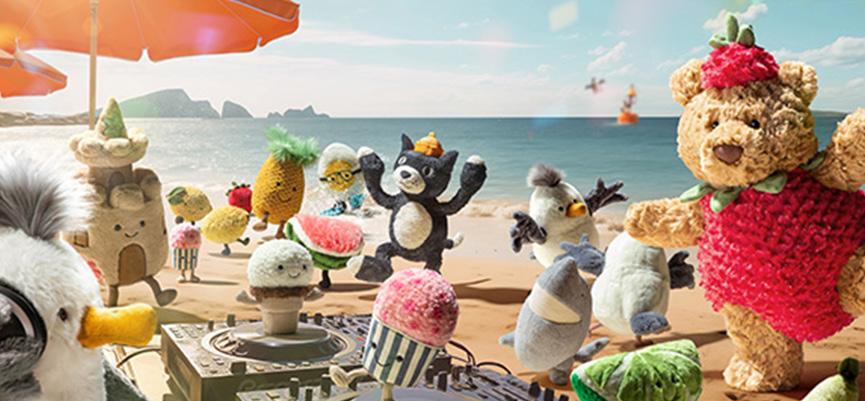
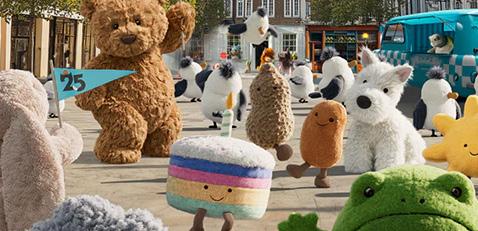
Jellycat’s financial performance has shown steady growth over the years, solidifying its reputation as a global leader in the plush toy market. Founded in 1999, the company experienced moderate success in its early years, primarily driven by its unique designs and high-quality materials. However, as Jellycat expanded its product lines and increased its international presence, profitability began to rise significantly. The company gained traction, particularly with its signature “Bashful Bunny” line, which became a top-selling item in the luxury toy segment.
In recent years, Jellycat’s profits have surged, reflecting its strategic market positioning and robust brand appeal. In 2023, the company reported an impressive 24% increase in pre-tax profits, bringing the total to £67 million. This marked a substantial improvement over the previous year, during which Jellycat already saw notable growth. This profit rise is largely due to Jellycat’s increasing global demand, with significant sales coming from Europe, North America, and Asia. The brand’s appeal acrossdifferent cultures and demographics has been key to its continued financial success.The company’s shift toward a more diversified sales strategy, balancing online and retail channels, has also played a pivotal role in its financial performance. Digital presence and making its products more accessible worldwide. Simultaneously, partnerships with high-end retailers such as Harrods, Nordstrom, and other prestigious stores have contributed to
increased visibility and sales. This omnichannel approach has provided multiple revenue streams, which helped stabilize and boost profitability.
Jellycat has also demonstrated strong financial stewardship by returning value to shareholders. In 2023, the company declared dividends amounting to £58 million, signaling confidence in its continued profitability. This dividend payout reflects Jellycat’s solid financial health, with strong cash flows enabling the company to reward its investors while maintaining its operations and expansion strategies. These financial moves highlight the company’s ability to balance profitability with long-term growth initiatives.
Overall, Jellycat’s profit trajectory over the years illustrates a well-executed growth strategy, fueled by product innovation,international expansion, and effective use of digital and physical retail channels. Looking forward, as the brand continues to innovate and cater to new markets, Jellycat is well-positioned to maintain its profitability and leadership in the plush toy industryfor years to come. Jellycat has maintained financial stability and consistent growth since its founding in 1999. With a strong brand presence and increasing popularity for plush toys, Jellycat is expected to continue thriving in the premium toy market.
Property, plant and equipment are stated at cost less accumulated depreciation and any provision for impairment in value. Cost includes the original purchase price of the asset and the costs attributable in bringing the asset to its working condition for its intended use. Depreciation is provided to write down the cost of property, plant and equipment to their estimated residual values, based on current values at the reporting date, over their remaining useful lives using the straight-line method. Assets under construction are not depreciated. Residual values and useful lives are assessed at each reporting date. The applicable depreciation rates are:
12.5% - 25%
Machinery and equipment
12.5%-25%
25%
At each reporting date, property, plant and equipment is reviewed for impairment if events or changes in circumstances indicate that the carrying amount may not be recoverable. When a review for impairment is conducted, the
recoverable amount is assessed by reference to the net present value of expected future pretax cash flows of the relevant cash-generating unit or fair value, less costs to sell if higher.Any impairment in value is charged to the Income Statement in the period in which it occurs.
Invent ories are valued at the lower of cost and net realisable value, on a first in first out (FIFO) cost basis. Cost of purchase comprises the purchase price including import duties and other taxes, transport and handling costs and any other directly attributable costs, less trade discounts. A provision is made to write down any slow-moving or obsolete inventory to net realisable value. Net realisable value represents the estimated selling price less all estimated costs of completion and costs to be incurred in marketing, selling and distribution.
Financial asse ts and financial liabilities are recognised when the Company becomes a party to the contractual provisions of the relevant.
Property, plant and equipm ent are stated at cost less accumulated depreciation and any provision for impairment in value. Cost includes the original purchase price of the asset and the costs attributable in bringing the asset to its working condition for its intended use. Depreciation is provided to write down the cost of property, plant and equipment to their estimated residual values, based on current values at the reporting date, over their remaining useful lives using the straight-line method. Reviewed for impairment if events or changes in circumstances indicate that the carrying amount may not be recoverable. When a review for impairment is conducted, the recoverable amount is assessed by reference to the net present value of expected assets are classified as loans.
Trade and other receivables are non-interest bearing and are initially recognised at fair value. Subsequently they are measured at amortised cost using the effective interest rate method less provision for impairment. A provision for impairment of trade receivables is established when there is objective evidence that the Company will not be able to collect all amounts due according to the original terms of the receivables. Significant financial difficulties of the debtor, probability that the debtor will enter bankruptcy or financial reorganisation, and default or delinquency in payments (more than 30 days overdue) are considered indicators that the trade receivable is impaired. Any provision made against an impaired receivable is charged through the Income State.
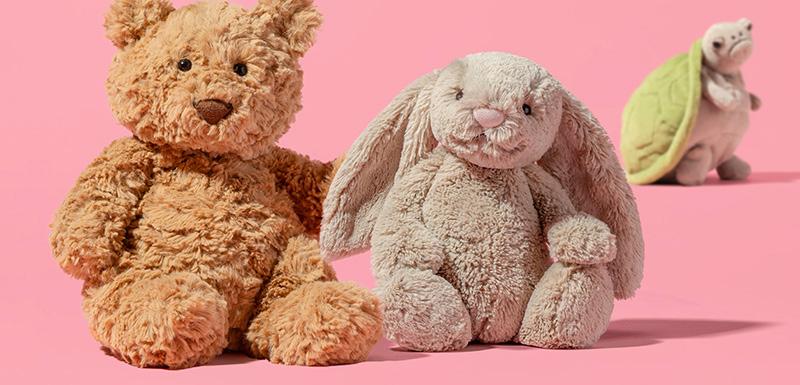

Thomas Gatacre
CO Founder of JellyCat

Beverley Longton
Global ecommerce Director Leadership Team

Holly Ashby Global Product Director Leadership Team

Paul
Dryden
Chief Technology Officer Leadership Team
We recognise that employees are fundamental to our continued and future success. We seek to retain, attract and motivate employees by being an open, responsible employer that communicates well, demonstrating our high regard for pay and benefits, health and safety and a positive, enjoyable working environment.
We build long-term collaborative relationships with customers, suppliers and others, always abiding by clear and fair commercial terms and working proactively to drive productivity and efficiency for the mutual benefit of all.
The com pany's energy use for the year ended 31 December 2023 was 495,885, kWh (2022: 466,022), and reclaimed employee mileage of 8,073 miles (2022: 3,717) and total greenhouse gas (GHG) emissions were 111 tonnes of CO2 (tCO2) (2022: 99 tonnes).
The company measures emissions intensity with the ratio of tCO2 per £m revenue. In 2023, this ratio was 0.56 for the company (2022: 0.67). Energy usage was obtained from a variety of sources including external invoices and external information. The CO2 emissions calculation is based on energy consumption and CO2 emission factors as outlined in Greenhouse gas reporting: conversion factors 2023 issued by Department for ESNZ in June 2023.
The company is committed to reducing its impact on the environment and continues to take steps to reduce the energy consumption and GHG emissions of our warehouse and offices through reducing the use of electricity and gas; reducing the amount of un-recyclable products used; increasing the use of recyclable products; and developingn materials for our products and packaging that are partially, or wholly, recycled.
Our Section 172 Statement on page 5 describes in further detail how we make strategic decisions with regard to the interests of employees, customers, suppliers and other stakeholders.
The long- term success of our business is dependent on building strong supportive relationships and shared values with our stakeholders, which includes:
• Shareholders
• Colleagues
• Customers
• Suppliers
• Lenders
• Communities
• Government and regulators
We recognise the wide role which the Company plays in both the business community and society as a whole and we hold principles of honesty, trust, i ntegrity and respect as our core values.
We cite the following topic, as practical examples of strategic decision-making made with a high regard to interests of a broad range of stakeholders:
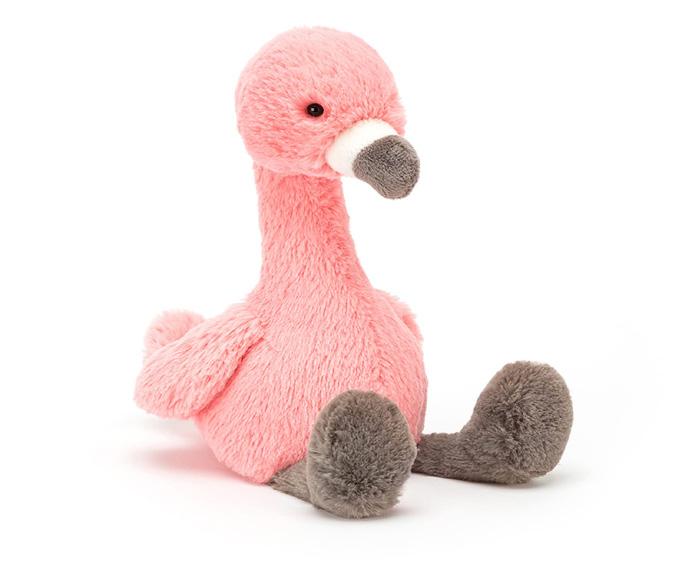
Inflation continues to be a challenge to the business which requires rapid decision making and significant adaptation to our operations. All such decisions were made with high regard for the impact on stakeholders, such as:
Ad apting and improving our reporting and forecasting to include additional information relating to margins, and additional scrutiny over costs and expenses to ensure we meet expected performance.
Giving employees confidence of security during uncertain times, and recognising the talents, skills and dedication that are fundamental to overcoming difficulty and creating success.
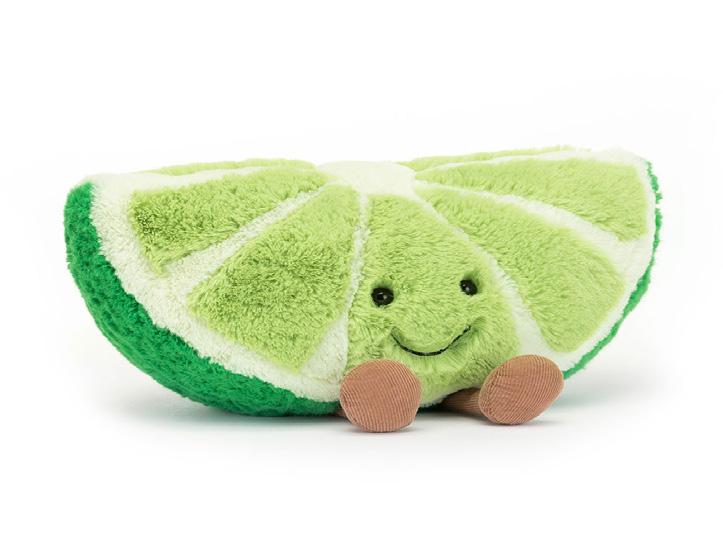

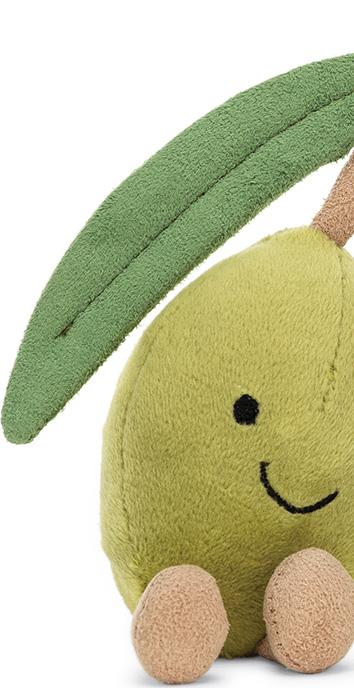
Offering flexi bility and understanding to customers and suppliers, and focussing on long term relationship and mutual support as the key to working through challenging times together.
Aligning the interests of lenders and the business, making decisions and plans which create certainty and stability.
building strong and lasting relationships with all stakeholders and especially so during periods of significant change and uncertainly such as periods of high inflation.
Company law requires the directors to prepare financial statements for each financial year. Under that law the directors have prepared the Company’s financial statements in accordance with United Kingdom Accounting Standards (United Kingdom Generally Accepted Accounting Practice), including Financial Reporting Standard 101 “Reduced Disclosure Framework.


Under co mpany law the directors must not approve the• financial statements unless they are satisfied that they give a true and fair view of the state of affairs of the Company and of the profit or loss of the Company for that period.
In preparing these fi nancial statements, the directors are required to select suitable accounting policies and then apply them consistently; make judgements and accounting estimates that are reasonable and prudent; state· whether applicable United Kingdom Accounting Standards, including FRS 101, have been followed, subject to any material departures disclosed and explained in the financial statements; notify the Company’s shareholders in writing about the use of disclosure exemptions, if any, of FRS 101, used in the preparation of financial statements; and prepare the financial statements on a going concern basis unless it is inappropriate to presume that the Company will continue in business.


In our opinion the financial statements:
• give a true and fair. view of the state of the company's affairs as at 31 December 2023 and its profit for the year then ended;
• have been properly prepared in accordance with United Kingdom . Generally Accepted Accounting Practice including FRS 101; and
• have been prepared in accordance with the requirements of the Companies Act 2006.
We conducted ou r audit in accordance with International Standards on Auditing (UK) (ISAs (UK)) and applicable law. Our responsibilities under those standards are further described in the Auditor's responsibilities for the audit of the financial statements section of our report. We are independent of the company in accordance with the ethical requirements that are relevant to our audit of the financial statements in the UK, including the FRC's Ethical Standard, and we have fulfilled our other ethical responsibilities in accordance with these requirements.
• We believe that the audit evidence we have obtained is sufficient and appropriate to provide a basis for our opinion.
In auditing the fi nancial statements, we have concluded that the directors' use of the going concern basis of accounting in the preparation of the financial statements is appropriate. Based on the work we have performed, we have not identified any material uncertainties relating to events or conditions that, individually or collectively, may cast significant doubt on the company's ability to continue as a going concern for a period of at least twelve months from when the financial statements are authorised for issue.
Our responsibilities and the responsibilities of the directors with respect to going concern are described in the relevant sections of this report.
The directors are responsible for the other information. The other information comprises the information included in the annual report, other than the financial statements and our auditor's report thereon. Our opinion on the financial statements does not cover the other information and, except to the extent otherwise
explicitly stated in our report, we do not express any form of assurance conclusion thereon.
In connection with our audit of the financial statements, our responsibility is to read the other information and, in doing so, consider whether the other information is materially inconsistent with the financial statements or our knowledge obtained in the audit or otherwise appears to be materially misstated.
If we identify such material inconsistencies or apparent material misstatements, we are required to determine whether there is a material misstatement in the financial statements or a material misstatement of the other information.
If, based on the work we have performed, we conclude that there is a material misstatement of this other information; we are required to report that fact.
In our op inion, based on the work undertaken in the course of the audit:
• the information given in the Directors' Report for the financial year for which the financial statements are prepared is consistent with the financial statements
• the Directors' Report has been prepared in accordance with applicable legal requirements.
